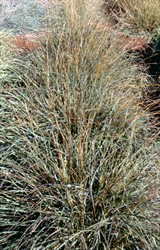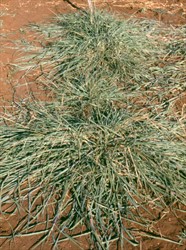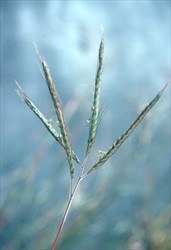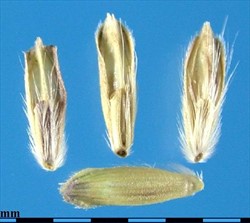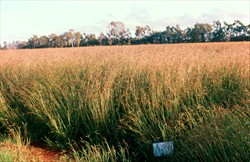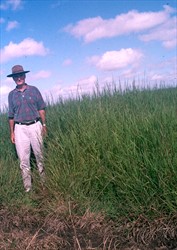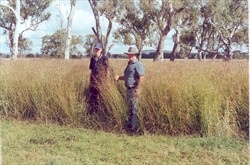Dichanthium aristatum
Tropical Forages
Dichanthium aristatum (Poir.) C.E. Hubb.
Basionym: Andropogon aristatus Poir.; Andropogon nodosus auct.
Family: Poaceae (alt. Gramineae) subfamily: Panicoideae tribe: Andropogoneae subtribe: Anthristiriinae.
Tufted, shortly rhizomatous perennial with slender stems and varying degrees of stolon development. Young plants prostrate to semi-erect with foliage to 80 cm, becoming erect at maturity, culms geniculate to 1‒1.8 m at maturity; nodes glabrous or short woolly. Leaf blades linear, 3‒25 cm long, 2‒8 (‒10) mm wide, glabrous or thinly pilose on both surfaces; ligule c. 0.6 mm, minutely fimbriate. Primary peduncle softly pilose for 1.5‒2.5 cm immediately below the inflorescence. Inflorescence a sub-digitate panicle, comprising (1–) 2‒6 (‒10) flexuous racemes 2‒5 (‒8) cm long; secondary peduncles pubescent; racemes hairy, awns on each spikelet pair from (12‒) 16‒30 mm long. Caryopsis ellipsoid, longitudinally grooved, hilum long-linear; c. 1.8 mm long. 500,000-1 million seed units (sessile spikelet + pedicellate spikelet)/kg.
Similar species
D. aristatum: peduncle nodes glabrous or shortly pubescent; short, dense pubescence on peduncle immediately below lowest raceme.
D. annulatum: peduncle nodes with annulus of long hairs; peduncle internodes glabrous.
D. caricosum: peduncle nodes glabrous or shortly pubescent; peduncle internodes glabrous.
Asia: 毛梗双花草 mao geng shuang hua cao (China); オニササガヤoni-sasa-gaya (Japan); หญ้าแอนเกิ้ลตั้น ya aen koen tan (Thailand)
English: angleton grass (Australia, USA, Cuba); alabang X (Philippines); angleton blue-stem, awned dichanthium, medio bluestem, yellow bluestem (USA); wildergrass (Hawai'i); Antigua hay grass (Caribbean); swamp grass (New Caledonia)
Latin America: dicantio matoso, dicantio erecto, hierba angleton, pasto angleton, popotillo robusto, puntero (Spanish)
Native:
Asia: China (Yunnan); India; Indonesia; Malaysia; Taiwan
Naturalized:
Australasia: Australia (NSW, Queensland, Northern Territory, Western Australia)
Northern America: USA (Texas)
Cultivated:
Australasia: Australia (NSW, Queensland, Northern Territory, Western Australia)
Northern America: USA (Texas)
Forage
Permanent pasture in seasonally flooded or waterlogged land. Suitable for grazing and cut-and-carry, and for hay before flowering.
Environment
Well-suited to waterway and bank stabilisation, and suppression of invasive weeds such as Phyla canescens (Verbenaceae) in flood-plain areas.
Soil requirements
Occurs mostly on dark or red clay or clay-loam soils, with a neutral to alkaline pH. Can extend onto hard setting duplex soils if moisture is adequate. Generally not suited to light textured soils, but will grow on calcareous sands. Often found on fertile soils, but not fertility demanding. Tolerant of salinity, but not to the same degree as Chloris gayana.
Moisture
Mostly in moderately dry to moist areas with annual summer rainfall from 700 to 1,400 mm, but also as low as 620 mm and as high as 2,000 mm, sometimes with a long dry season. Moderately drought tolerant, although killed out by prolonged dry conditions. Very tolerant of flooding and waterlogging. Appears to need better moisture conditions than Dichanthium annulatum and Bothriochloa insculpta.
Temperature
Largely a warm season grass. Produces little growth in spring in the subtropics, but good summer-autumn feed. Tops are burnt off by frost, but plants regrow with the onset of warmer conditions. Occurs in the wild at altitudes from sea level to >800 m asl, and is naturalized at similar altitudes in northern Australia and up to 1,500 m asl in South Africa. Although largely of tropical origin, it has become naturalized in USA, Australia and Africa to about 30º latitude.
Light
Appears to have moderate shade tolerance, but not as good as grasses such as Ischaemum aristatum, Stenotaphrum secundatum and Axonopus compressus.
Reproductive development
Obligate, short day plant, with flowering commencing 60‒100 days (and up to 125 days) after the summer solstice, depending on ecotype and growing conditions.
Defoliation
Very tolerant of heavy grazing.
Fire
Tolerant of fire, but usually escapes severe fire by virtue of being palatable and well grazed, thus providing a low fuel load.
Guidelines for establishment and management of sown forages.
Establishment
Fresh seed has low germination and takes 6‒7 months to reach maximum germination. Establishes well from seed broadcast onto a cultivated surface, or after fire, sown at 2‒4 kg/ha. Seed is fluffy, so there may be benefit in pelleting de-awned seed, to make it easier to pass through planting equipment. Has vigorous seedlings, establishing as readily as Bothriochloa insculpta and Panicum coloratum, but not as readily as Setaria incrassata. Also propagated by runners, 30‒45 cm apart in rows 1 m apart.
Fertilizer
Low P requirement, but can give 3-fold yield response to 100‒200 kg/ha N. May need at least 1 t/ha lime to succeed on acid soils.
Compatibility (with other species)
Invades less grazing tolerant communities, e.g. Heteropogon contortus and Dichanthium sericeum, under heavy grazing. Does not invade vigorous sown pasture.
Companion species
Grasses: Bothriochloa insculpta, Dichanthium annulatum, D. caricosum, Panicum coloratum, Setaria incrassata.
Legumes: Few legumes adapted to the seasonally poorly drained situations where Dichanthium aristatum thrives.
Pests and diseases
Ergot (Claviceps pusilla) can cause problems in seed production, although varieties are available with minimal incidence of the disease. Dichanthium aristatum is an alternative host for sheath blight of rice caused by Rhizoctonia solani, and can infect adjacent rice crops. Other fungal organisms isolated include Puccinia kenmorensis (rust), Curvularia gudauskasii and Cerebella andropogonis.
Ability to spread
Spreads by seed, and slowly by stolons.
Weed potential
It is a vigorous grass with a tendency to dominate and become a weed in some areas. Not usually considered a significant weed in cropping.
Nutritive value
CP values are often low, but can be increased by N fertilization (e.g. 5.9% CP without applied N, 8.6% CP with 120 kg/ha N). Up to 12.5% CP in young foliage.
Palatability/acceptability
Well eaten by all classes of stock when leafy. Acceptable to cattle but not sheep when mature. Selected over Heteropogon contortus in mixed stands.
Toxicity
Low in oxalate, therefore safe for horses.
Dry matter
Hay yields of 4.5‒13.5 t/ha (av. 9 t/ha). Under favourable conditions, 11 t/ha DM (equivalent to Panicum coloratum and Cenchrus ciliaris).
Animal production
Liveweight gain of 140 kg/hd (272 kg/ha) from mid-summer to early winter (164 days) on Dichanthium aristatum/Stylosanthes humilis pasture.
Facultative apomict, the level of apomixis (in some lines at least) increasing with reducing daylength during floral development. 2n = 20, 40, 60, tetraploid most common. Can hybridize with D. annulatum and D. caricosum at the tetraploid level, and with D. caricosum at the diploid level producing diploids and tetraploid progeny.
Seed production improved 2- to 3-fold by nitrogen application. For a late flowering variety, cut the sward back to 10 cm in February (southern hemisphere) or August (northern hemisphere), and fertilize with 100‒120 kg/ha N. Plants will flower in mid to late April/October respectively, and be ready to harvest about 12 to 25 May/November. Seed sheds on maturity, and must be harvested within a 4‒5 day period if large losses are to be avoided. Under good growing conditions, and using mechanical harvester, yields of 200‒300 kg/ha are common; crops that are subjected to moisture stress may yield only 40‒70 kg/ha seed. Early flowering varieties can produce two crops per year, each of 75‒150 kg/ha seed, particularly if irrigated. Can be harvested by hand or mechanically by direct heading, stripping or brush harvesting.
Tolerant of atrazine, which appears safe when applied either pre- or post-emergent. Can also use metsulfuron methyl, clopyralid and 2,4-D amine for the control of broad leaf weeds. Application of 2,4-D and clopyralid should be delayed until seedlings have established secondary roots.
- Palatable.
- Grows on poorly drained and seasonally flooded soils.
- Drought tolerant.
- Salt tolerant..
- Withstands heavy grazing.
- Suppresses weeds.
- Can invade native grassland under heavy grazing.
- Relatively low production.
- Restricted to alkaline (or near neutral) soils.
- Relatively low quality in some varieties.
- Fluffy seed difficult to sow.
Bisset, W.J. and Sillar, D.I. (1984) Angleton Grass (Dichanthium aristatum) in Queensland. Tropical Grasslands 18:161–174. bit.ly/2wADSXw
'Medio' (NSL 20670, NSL 22695, PI 469252) Released in USA (1954). Naturalized ecotype, first noticed in 1940 along Medio Creek in Bee County, Texas. Fine stemmed. Prostrate stems will form sward, seed stems to 750 mm. Best adapted to heavy soils, which may experience periodic flooding, but also in shallow sandy soils overlying clay at 50 cm or less.
'Gordo' (PI 190302, BN-6851, T-20062, NSL 22694) Released in USA (1957). Institutional donation from Transvaal, South Africa. Seedlings prostrate. Leafy, dark green, with stems to 1.8 m at maturity. Good seed producer.
'Alabang X' (PI 297430) Released in the Philippines. Short creeping grass with stolons up to 3 m long in the wet season, rooting at the nodes. Slow to establish and susceptible to weed competition when young. Best on poorer soils because dominated by more productive grasses on fertile soils. Moderately shade tolerant. Erroneously referred to as var. heteropogonoides, but may in fact be an ecotype of D. caricosum. "The most productive and nutritious grass in the Philippines, comparing favorably with pangolagrass under low elevations and hot climates."
'T 587', 'PMT-587' Released in USA (1981). Derived from a composite of 50 Dichanthium accessions established in 1962. Winter temperatures from 1962 to 1980 removed a proportion of genotypes, with possibly only 20 of the original accessions remaining. Suitable for pasture, hay, revegetation of disturbed areas and salt scalds, erosion control, and range reseeding. More cold tolerant than 'Gordo', 'Medio' and 'Kleberg'. Leafier than 'King Ranch', leaves longer and wider. Resistant to leaf rust. High forage producer. Grows from late winter/early spring through late fall. Performs well on sandy clay loam and clay loam sites in the >625 mm rainfall areas of southern Texas.
'Floren' (CPI 106374) Released in Australia (1995). Origin Karnataka, India (15º N, 620 m asl, 850 mm rainfall). Leafy, very palatable ecotype. Culms to 1.8 m at maturity. Late flowering (125 days after the summer solstice in the subtropics); low incidence of ergot. Not strongly stoloniferous, but forms close sward through rooting at nodes of prostrate culms. Suppresses Chloris gayana under heavy grazing. Effective suppression of the weed, Phyla canescens, in floodplain situations.
CPI 104839 Selected in Australia. Origin Madhya Pradesh, India (22º N, 490 m asl, 1,430 mm rainfall) growing on a cracking clay of pH 8.5‒9. Vigorous type with culms to 1.7 m at maturity. Flowers about 1 week earlier than 'Floren'. Stronger stolon development, and similar ergot resistance.
